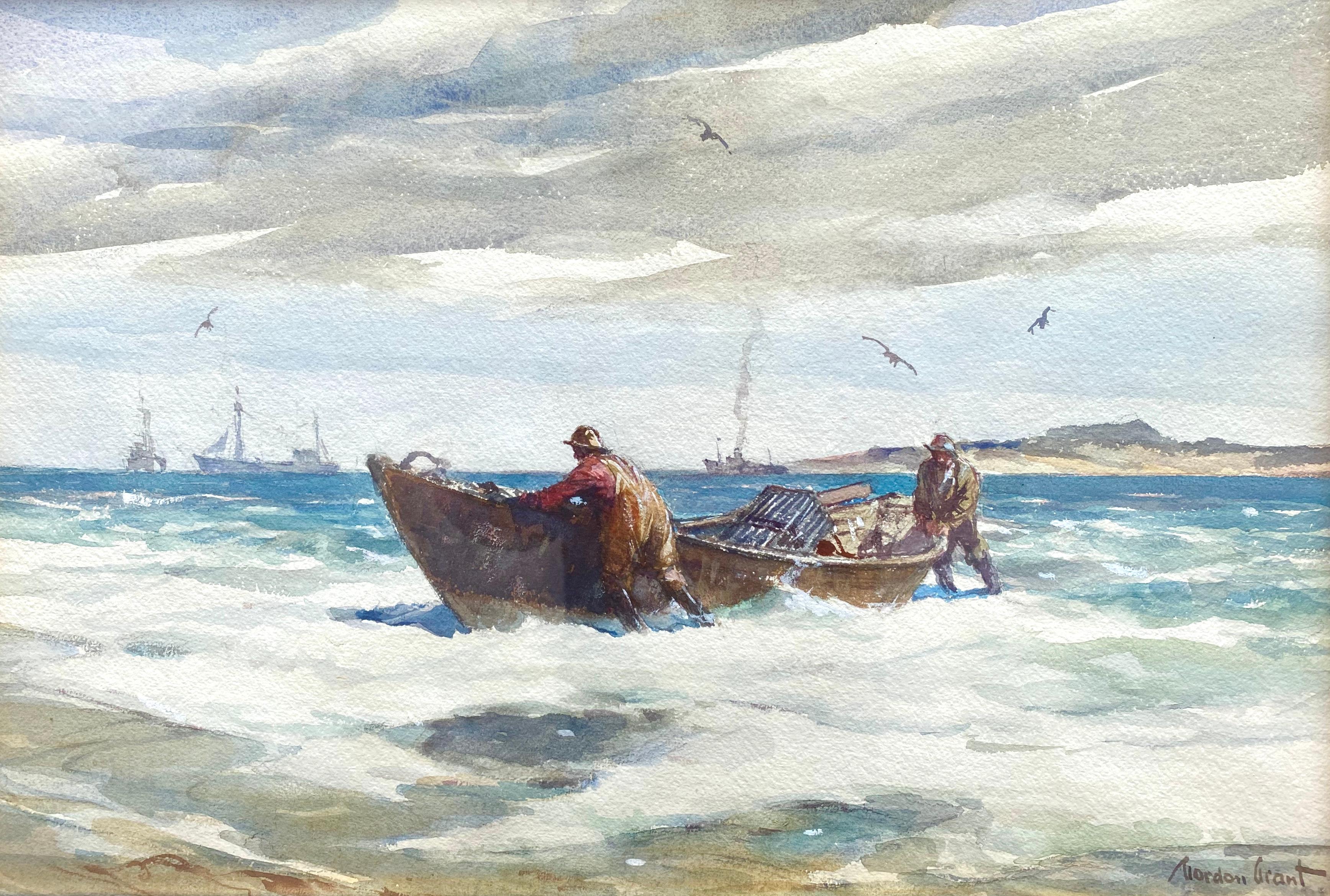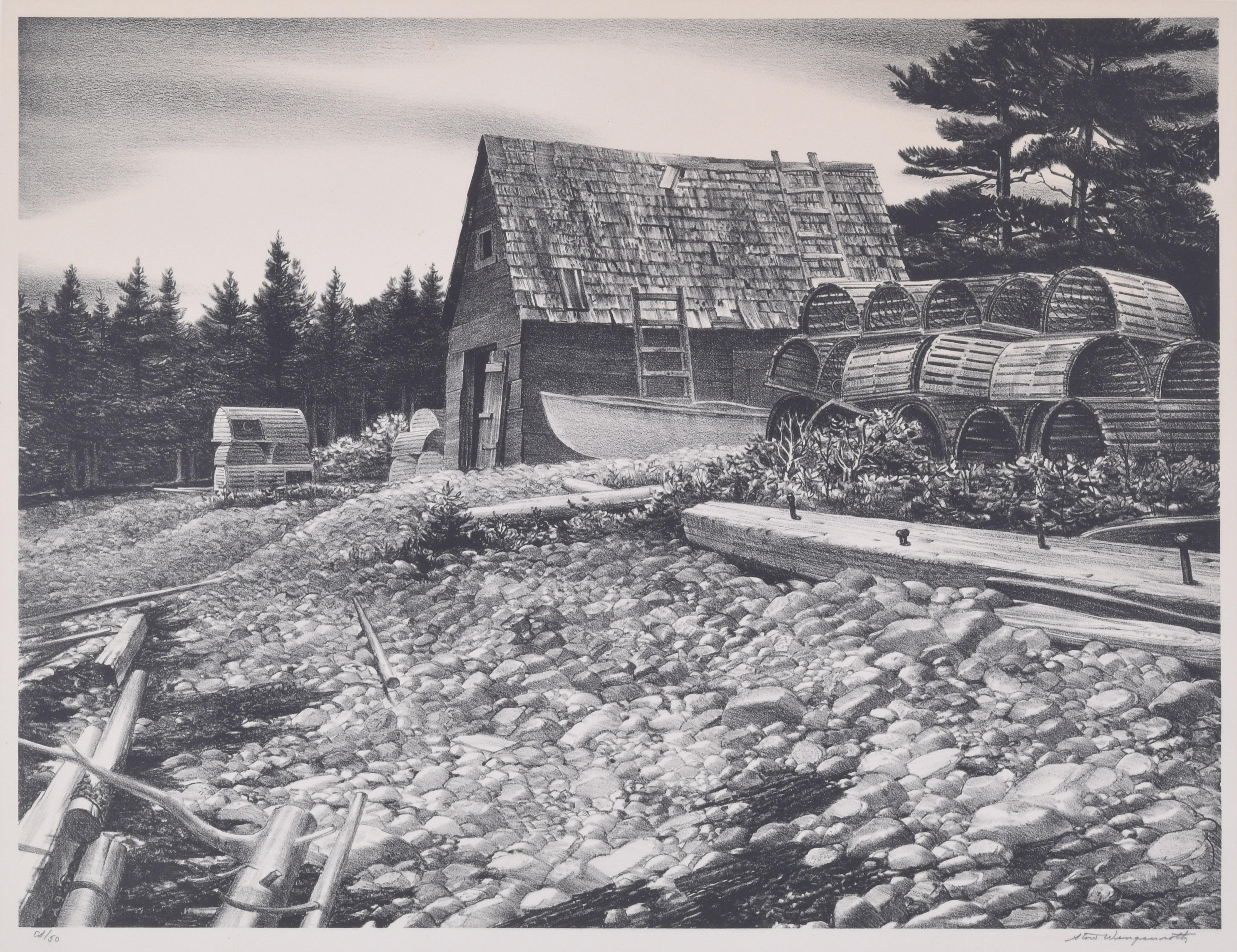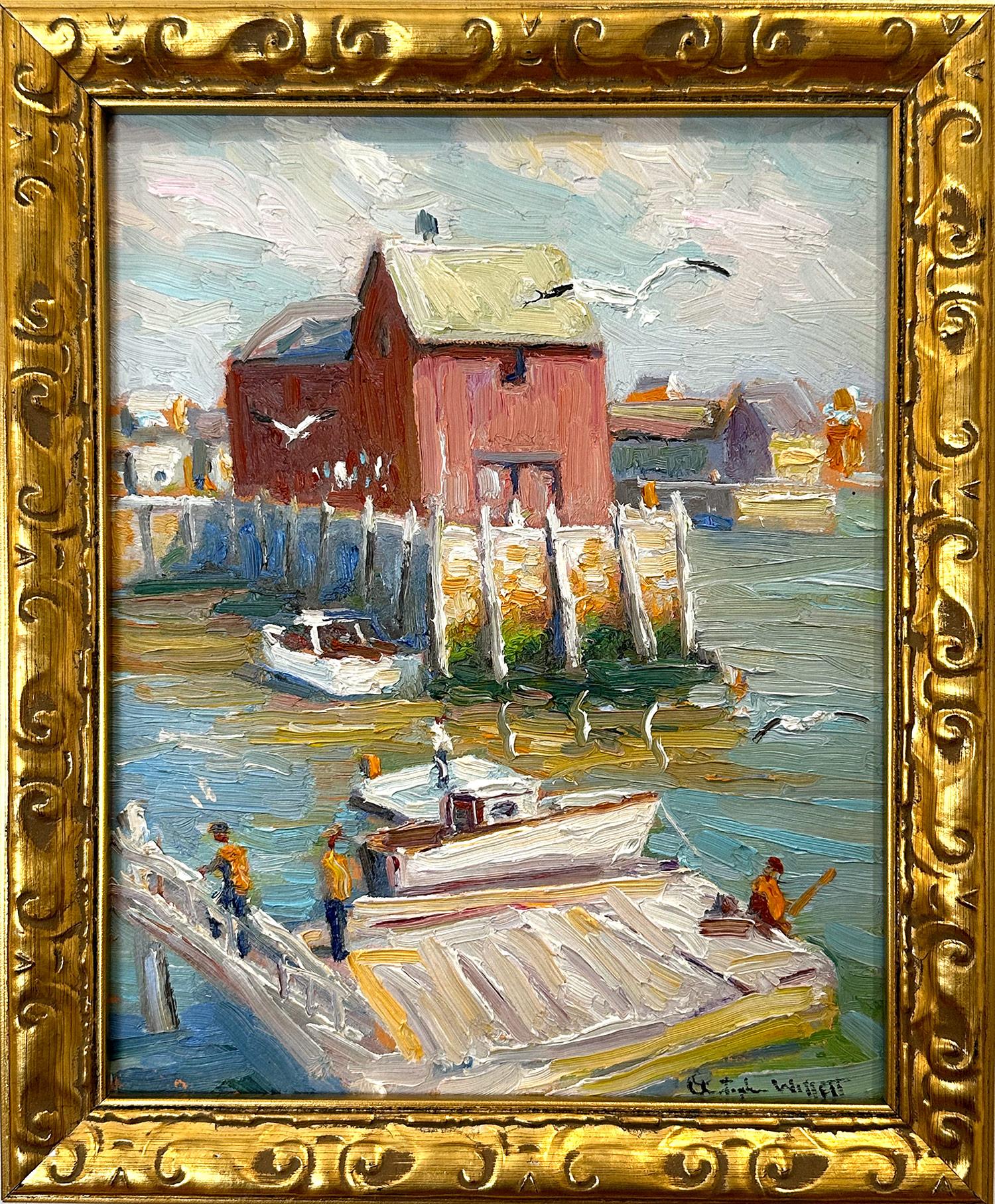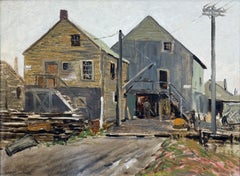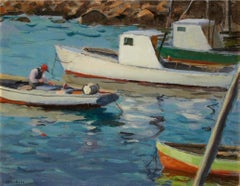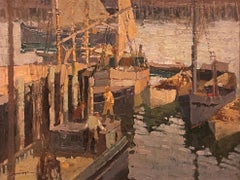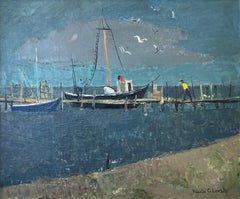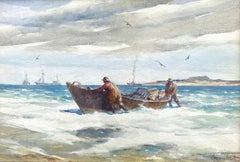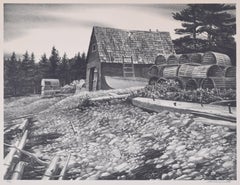Items Similar to "Lobstermen in Gloucester, Mass." Lionel Reiss WPA Social Realism Fishermen
Want more images or videos?
Request additional images or videos from the seller
1 of 9
Lionel S. Reiss"Lobstermen in Gloucester, Mass." Lionel Reiss WPA Social Realism Fishermencirca 1943
circa 1943
$3,200
$4,00020% Off
£2,429.39
£3,036.7320% Off
€2,778.70
€3,473.3720% Off
CA$4,470.86
CA$5,588.5820% Off
A$4,972.58
A$6,215.7220% Off
CHF 2,596.53
CHF 3,245.6620% Off
MX$60,510.97
MX$75,638.7120% Off
NOK 33,161.59
NOK 41,451.9820% Off
SEK 31,099.72
SEK 38,874.6520% Off
DKK 20,738.49
DKK 25,923.1220% Off
Shipping
Retrieving quote...The 1stDibs Promise:
Authenticity Guarantee,
Money-Back Guarantee,
24-Hour Cancellation
About the Item
Lionel S. Reiss (1894 - 1988)
Lobstermen in Gloucester, Massachusetts, circa 1943
Watercolor on paper
Sight 17 1/2 x 23 inches
Signed lower left
Provenance:
Private Collection, Las Vegas, Nevada
In describing his own style, Lionel Reiss wrote, “By nature, inclination, and training, I have long since recognized the fact that...I belong to the category of those who can only gladly affirm the reality of the world I live in.” Reiss’s subject matter was wide-ranging, including gritty New York scenes, landscapes of bucolic Bucks County, Pennsylvania, and seascapes around Gloucester, Massachusetts. However, it was as a painter of Jewish life—both in Israel and in Europe before World War II—that Reiss excelled. I.B. Singer, the Nobel Prize winner for Literature, noted that Reiss was “essentially an artist of the nineteenth century, and because of this he had the power and the courage to tell visually the story of a people.”
Although Reiss was born in Jaroslaw, Poland, his family immigrated to the United States in 1898 when he was four years old. Reiss's family settled on New York City’s Lower East Side and he lived in the city for most of his life. Reiss attended the Art Students League and then worked as a commercial artist for newspapers and publishers. As art director for Metro-Goldwyn-Mayer, he supposedly created the studio’s famous lion logo.
After World War I, Reiss became fascinated with Jewish life in the ‘Old World.’ In 1921 he left his advertising work and spent the next ten years traveling in Europe, the Middle East, and North Africa. Like noted Jewish photographers Alter Kacyzne and Roman Vishniac, Reiss depicted Jewish life in Poland prior to World War II. He later wrote, “My trip encompassed three main objectives: to make ethnic studies of Jewish types wherever I traveled; to paint and draw Jewish life, as I saw it and felt it, in all aspects; and to round out my work in Israel.”
In Europe, Reiss recorded quotidian scenes in a variety of media and different settings such as Paris, Amsterdam, the Venice ghetto, the Jewish cemetery in Prague, and an array of shops, synagogues, streets, and marketplaces in the Jewish quarters of Warsaw, Lodz, Krakow, Lublin, Vilna, Ternopil, and Kovno. He paid great attention to details of dress, hair, and facial features, and his work became noted for its descriptive quality.
A selection of Reiss’s portraits appeared in 1938 in his book My Models Were Jews. In this book, published on the eve of the Holocaust, Reiss argued that there was “no such thing as a ‘Jewish race’.” Instead, he claimed that the Jewish people were a cultural group with a great deal of diversity within and between Jewish communities around the world. Franz Boas, the founder of modern anthropology, contributed the introduction to the book to support Reiss’s view. Unfortunately, the Nazis thought otherwise and initiated a policy of genocide against the Jewish ‘race’ that ultimately murdered 6 million Jews. After World War II, Reiss wrote, “Doubtless most of my models in Central and Eastern Europe were numbered among the millions of victims. They have haunted me for years.”
Reiss had first observed life in Israel in 1930-31 under the British mandate. In 1952, the Jewish Reconstructionist movement gave Reiss a grant that allowed him to devote six months to traveling through Israel and depicting what he saw. In Israel, he gushed, “there is a lifetime of possibilities in the inexhaustible themes.” In 1954, Reiss published his second book, New Lights and Old Shadows. It contained 210 paintings, watercolors, drawings, and etchings that dealt with “the new lights” of a reborn Israel and the “old shadows” of a European Jewish culture that had been almost wiped out. Reiss reprised the same theme in his last book, A World of Twilight [1972]. He continued painting almost until his death.
Lionel Reiss’s strong Jewish identity and his premonition that European Jewish life itself was in danger of vanishing helped him create a record of that culture. “It was my hope,” he later wrote, “that by pencil and brush I might perpetuate many of the visual aspects of a people whose patterns of life were rapidly changing, and whose memorable landmarks were vanishing.” Thanks to his work, the faces, ghetto architecture, synagogues, and alleyways all remain to remind the viewer of a time and place that no longer exist.
- Creator:Lionel S. Reiss (1894-1988, American)
- Creation Year:circa 1943
- Dimensions:Height: 29 in (73.66 cm)Width: 33.5 in (85.09 cm)
- Medium:
- Movement & Style:
- Period:
- Condition:
- Gallery Location:New York, NY
- Reference Number:1stDibs: LU184129905762
About the Seller
5.0
Platinum Seller
Premium sellers with a 4.7+ rating and 24-hour response times
Established in 2022
1stDibs seller since 2022
114 sales on 1stDibs
Typical response time: <1 hour
- ShippingRetrieving quote...Shipping from: New York, NY
- Return Policy
Authenticity Guarantee
In the unlikely event there’s an issue with an item’s authenticity, contact us within 1 year for a full refund. DetailsMoney-Back Guarantee
If your item is not as described, is damaged in transit, or does not arrive, contact us within 7 days for a full refund. Details24-Hour Cancellation
You have a 24-hour grace period in which to reconsider your purchase, with no questions asked.Vetted Professional Sellers
Our world-class sellers must adhere to strict standards for service and quality, maintaining the integrity of our listings.Price-Match Guarantee
If you find that a seller listed the same item for a lower price elsewhere, we’ll match it.Trusted Global Delivery
Our best-in-class carrier network provides specialized shipping options worldwide, including custom delivery.More From This Seller
View All"On the Wharf" Everett Warner, Marine Town Scene, American Impressionism
Located in New York, NY
Everett Warner
On the Wharf
Signed lower left
Oil on panel
15 x 20 inches
Provenance
Cooley Gallery, Old Lyme, Connecticut
Everett Warner was born in...
Category
1930s American Impressionist Figurative Paintings
Materials
Oil, Panel
"Fisherman of Yankee Cove, " Harry Leith-Ross, Boat Landscape
By Harry Leith-Ross
Located in New York, NY
Harry Leith-Ross (1886 - 1973)
Fisherman of Yankee Cove
Oil on canvasboard
8 1/8 x 10 1/2 inches
Signed lower left; also with artist, title, and number '39' on label verso
Provenance:
Private Collection, Pennsylvania
Landscape painter Harry Leith-Ross was born in Mauritius in 1886, a British possession in the Indian Ocean. He came to America as a seventeen year old. Before beginning, some ten years later in 1914, his studies at the Art Students League Summer School in Woodstock, New York at the relatively late age of twenty-eight, Leith-Ross had worked as a commercial artist. He studied with John F. Carlson and Birge Harrison at the League Summer School, and later with C. Y. Turner at the National Academy of Design in New York City. He then went to Paris, studying with Jean Paul Laurens at the Academie Julien and in England with Stanhope Forbes.
Long associated with the Bucks County artists' colony in New Hope, Pennsylvania, Leith-Ross may have first gone there in 1912. It is definitely known that he visited the area in 1916 at the invitation of a student he had met when both attended the Art Students League Summer School in Woodstock, John Fulton Folinsbee. Birge Harrison, his former instructor at the League, whom he met again, was also there in New Hope during the winters from 1914 to 1916. The third and last generation of the New Hope colony would be comprised of artists like Leith-Ross, Folinsbee and Kenneth R. Nunamaker.
It is somewhat ironic that Leith-Ross, so long affiliated with the New Hope School of American Impressionism...
Category
Mid-20th Century American Impressionist Landscape Paintings
Materials
Oil, Board
"Gloucester Boats" Frederick Mulhaupt, Impressionist Gloucester Scene
Located in New York, NY
Frederick John Mulhaupt
Gloucester Boats
Signed lower left
Oil on board
12 x 16 inches
Born in Rock Port, Missouri, in 1871, Mulhaupt studied...
Category
Early 20th Century American Impressionist Figurative Paintings
Materials
Oil, Board
"Boats at Dock, Montauk" Nicolai Cikovsky, Long Island Fishing
By Nicolai Cikovsky
Located in New York, NY
Nicolai Cikovsky
Boats at Dock, Montauk
Signed lower right
Oil on canvasboard
20 x 24 inches
The well known and highly regarded landscape and figure painter Nicolai S. Cikovsky was born in Russia in 1894. He studied at the Vilna Art School, 1910-1914; the Penza Royal Art School, 1914-1918; and Moscow High Tech Art...
Category
Mid-20th Century Modern Landscape Paintings
Materials
Canvas, Oil
$6,000 Sale Price
20% Off
"Old Whaling Wharf, Newport, Rhode Island" Paulette Van Roekens, Impressionist
Located in New York, NY
Paulette Van Roekens
Old Whaling Wharf, Newport, Rhode Island, 1921
Signed and dated lower left
Oil on canvas
30 x 40 inches
Painter Paulette van Roekens was born in France and attended the Philadelphia School of Design for Women (now Moore College of Art and Design) and the Pennsylvania Academy of the Fine Arts. Her talent was recognized early on, and in 1916, she was awarded the John Sartain Fellowship at the Philadelphia School of Design. Her early paintings often were of still lifes, using flowers...
Category
1920s American Impressionist Figurative Paintings
Materials
Canvas, Oil
"Nantucket, Massachusetts" Helen Goodwin, American Impressionism Docks at Harbor
Located in New York, NY
Helen M. Goodwin (1865 - 1955)
Nantucket, Massachusetts
Oil on canvas laid on panel
12 x 16 inches
Signed and titled lower right
Helen M. Goodwin was born in New Castle, Indiana in ...
Category
Early 20th Century American Impressionist Landscape Paintings
Materials
Oil, Panel, Canvas
You May Also Like
“The Lobstermen”
By Gordon Grant
Located in Southampton, NY
Beautiful original watercolor and gouache on archival paper by the famous American marine artist, Gordon Grant. The artwork depicts two rugged lobstermen bringing their catch ashore...
Category
1930s American Realist Landscape Drawings and Watercolors
Materials
Watercolor, Gouache, Archival Paper
“Mending Nets”, Rockport, MA, bearskin neck Seascape of Fishermen working
Located in Rockport, MA
Painting is 13x16 inches w/o frame
"Mending Nets" is a Rockport, Massachusetts marine seascape of fishermen working on Bearskin Neck from approx. 1930s. Wonderfully rendered figures working are the main subject - the town of Rockport's church steeples stand in the background. Also, as an added bonus, the artist sketched...
Category
Mid-20th Century American Impressionist Landscape Paintings
Materials
Oil
Lobster Fishermen
Located in San Francisco, CA
This artwork titled "Lobster Fishermen" c.1945, is an oil painting on canvas by renown American impressionist artist Claude Curry Bohm, 1894-1971. It is signed at the lower left corner by the artist. The canvas size is 20 x 24 inches, framed size is 26.25 x 30.25 inches. Framed in a new wooden gold leaf plein air style frame. It is in excellent condition, it has been recently revarnish and new keys have been added to the canvas stretcher. Please note the the dark line on the top and left side of the painting are only the shadow, it is not a part of this artwork.
About the artist:
Claude Curry Bohm, a photographer, painter, and printmaker whose artistic career spanned five decades, was an integral part of the Chicago art scene in the 1920s and a very prominent part of the second generation of the Brown County...
Category
Mid-20th Century American Impressionist Figurative Paintings
Materials
Oil
Lobsterman's Cove, Winter Harbor, Maine
By Stow Wengenroth
Located in Fairlawn, OH
Lobsterman's Cove, Winter Harbor, Maine
Lithograph, 1941
Signed in pencil lower right (see photo)
Edition 50
Impressions are in the collection of the Pennsylvania Academy of the Fine...
Category
1940s American Realist Landscape Prints
Materials
Lithograph
Gloucester P-Town Pyle School Painting Henry J Peck - Portugese Fisherman
Located in Exton, PA
New England coastal scene painting by Henry Jarvis Peck. The artist attended the Rhode Island School of Design, studied with George Loftus Noyes, and moved to Wilmington Delaware in ...
Category
Early 20th Century American Realist Figurative Paintings
Materials
Oil
"Motif #1" Rockport Massachusetts Fishermen by the Seaport Docks Oil Painting
Located in New York, NY
Impressionist pastoral scene of a quaint marine view of the docks and fishermen of the iconic fishing shack on Bearskin Neck located on Bradley Wharf in the harbor town of Rockport, ...
Category
20th Century American Impressionist Landscape Paintings
Materials
Oil, Board
